A Better Sense of Place
This is a story of diversifying the species in a yard in Baton Rouge, Louisiana. I wanted to undo some of the damage that was done by replacing native species with exotic species. Few birds, few butterflies, constant maintenance (weeding, mowing, watering), complete disregard of the environmental uniqueness of place. I figured I could do better.
2013 October 20 (Sun)
Scarlet sage flowers
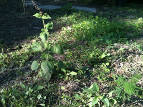
The scarlet sage are starting to flower. There are also a bunch of bundleflowers. I can't really identify much else right now, but this I know: the seeds did not take equally well to all parts of the rain garden. The places that are doing better are higher and sunnier. The low-lying areas and shady areas are very sparse. It's hard to tell which variable has the greater effect, but I think this will be a much longer term project than I had thought. It's going to take a while to figure out what will do well.
2013 October 6 (Sun)
PlantFest 2013
At the Hilltop Arboretum PlantFest, I bought two tulip trees and one American hornbeam for the front yard. For the back, I bought a maypop, inland seaoats, and a buttonbush. I only planted the three trees today since I already had places for them. The others, I'm not sure where they'll go yet. I'll probably put the maypop up against the fence somewhere. The other two will be in the rain garden.
2013 October 1 (Tue)
Plants for a rain garden
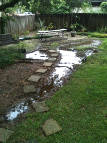
Another storm, more proof that it's a rain garden I built. I've started listing plants that would do well in all that water but still be ok when it's dry. My list has goldenrod, lyreleaf sage*, inland seaoats, buttonbush*, spiderwort, American beautyberry*, and Turk's cap. Depending on the price and availability, I might buy the ones with asterisks from the Hilltop Arboretum PlantFest on Saturday. Or I may just go with seeds and buy only trees (for my front yard plan).
2013 September 29 (Sun)
After the rains
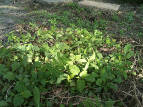
The rain last weekend helped out some of the sprouts while killing others. In the first three pictures, you can see that those in the "highlands" survived while those in the "lowlands" perished. This has made me rethink my haphazard plan. All the low parts where water collects should be a a different sort of plant: those that can be flooded. I initially thought of horsetail (Equisetum hyemale), but it is said to be very aggressive. I still haven't figured it out.
2013 September 22 (Sun)
Rain garden realization
It occurred to me this evening that I don't have a "wetland fringe". I have a rain garden. I may have been too eager to have a one-stop solution (seed mix) that I didn't really consider that I'd need to do more research on this as well. What happens in the area in question is that it's mostly dry, but sometimes it rains a lot. The majority of the backyard drains to it during heavy rain, and it's now responsible for retaining the water and processing it in some way. I'm two weeks away from the Hilltop Arboretum Fall PlantFest, so I've got some research to do to figure out what native plants are adapted to dealing with "mostly shaded (except for one sunny part) and dry but sometimes flooded for 24 hours" conditions.
2013 September 21 (Sat)
Flooded wetland area
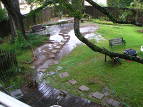
I'm a little worried now. It's been raining all night, and the backyard has standing water in my "wetland" area. I worry that the little sprouts will die in the flood. I'm really glad I have extra seeds now, but it wouldn't be too big of a deal to order another pack (17$). But really, I would hope that these species have evolved to handle this sort of thing.
2013 September 17 (Tue)
Starting a front yard plan
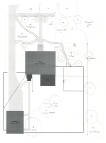
I'm now fairly certain that previous picture is of a partridge pea. They've gotten bigger and look a lot like the one that I have growing in the back alley. There are also so many of them that I figure they can't possibly be silk trees.
2013 September 8 (Sun)
The backyard is coming alive
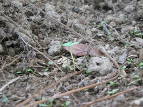
It rained three times this past week. I also watered before I knew the rain was coming. Lots of seeds have sprouted. I imagine most of them are the ones I sprouted, but I can't be sure until they get bigger. I think that second picture is of an Illinois bundleflower, which is exciting. I think I may have mistakenly plucked these up in the past because I thought they were silk trees.
2013 September 1 (Sun)
Seeding the Wetland Fringe area
I sowed the Wetland Fringe Mix today, but it left me unsure about how well "wetland" plants will do right there. I guess it hasn't rained in a long time, but the dirt is super dry. Maybe it won't be a big deal once everything is established and their roots have grown down. I only used maybe 2/3 of the pack. Native American Seed lists this size covering 500 square feet. I figured my area is around 200 square feet. I don't have anywhere else in mind to sow this stuff, so I think I'll wait a couple weeks and sow the rest in the same area, just to make sure it takes.
2013 August 31 (Sat)
Seeding the Chicken Yard
I did it: I sowed the Shade-Friendly Wildflower Mix in the chicken yard. I reread the Native American Seed webpage on how to do it and when the best time is. They said August to November, the sooner the better. So since it's almost September, surely now would be perfect.


